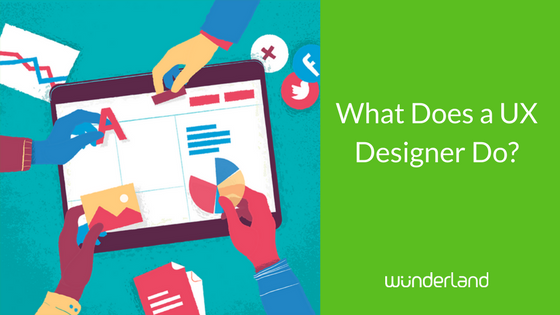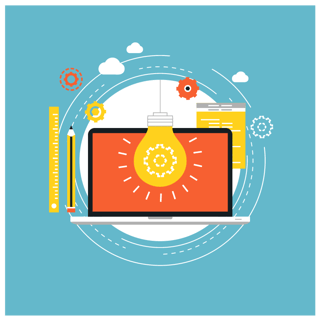
Depending on the size of your creative team, you may or may not have ever worked with a dedicated UX designer. So when it comes time to fit one into your workflow, or even to hire one for the first time, you may be a little stumped as to what to look for in their history, qualifications, and even the best way to incorporate one into your team. Here's a little breakdown to help you out.
First off, it's not pronounced "uhks" (true story, I encountered that once). It's short for User Experience designer (or sometimes UI designer, which stands for User Interaction designer, and other titles with similar terms). The full name gives you some insight to what they do for a living. In a nutshell, UX designers are tasked with making sure the final product (usually something interactive like a website or app or basically anything that has to be "experienced") makes sense for the end user.
Learn more. Read "A Day in the Life of an Associate User Experience Director" here.
When asked "what they do," many current UX designers point to the fact that the job is relatively new and not well understood.
Joe Torres, User Experience Architect for W.W. Grainger, Inc. remarked "The way I describe what I do is that I design sites/products/services so they're usable to their intended users. It usually invites more questions, particularly since most folks don't necessarily know that the UX profession even exists. Even within the UX field, there is debate among practitioners on what titles mean, who does what, and the distinctions between disciplines (like UI/UX, Design vs. Architecture, UX research.)."
 Twisha Shah-Brandenburg, a Design Planning Manager at RTC, Inc, remarked that you should expect UX designers at key points in the development process. "We usually come in during discovery to provide strategic insights and recommendations and then towards the end when a product, feature, service is prototyped and needs to be tested and different phases," she said.
Twisha Shah-Brandenburg, a Design Planning Manager at RTC, Inc, remarked that you should expect UX designers at key points in the development process. "We usually come in during discovery to provide strategic insights and recommendations and then towards the end when a product, feature, service is prototyped and needs to be tested and different phases," she said.
Duties for UX designers can vary, but often include a lot of the same types of activities, depending on the project.
Jon Hensley, a Senior User Experience Architect at Arity (owned by Allstate), remarked that his "typical duties are ideating and sketching ideas, creating user and system flow diagrams, prototyping experiences (low- through high-fidelity), research activities (interviewing, concept testing, usability testing), reading through secondary research for design best practices, and a bit of project managing."
Collaboration, collaboration, collaboration. If you have a designer who doesn't like being a team player, or a team that doesn't incorporate UX consultation at every step of the design and implementation process, you're in trouble.
Shah-Brandenburg said that the team approach is the only way to go with UX designers or planners. "A UX planner should be somebody willing to collaborate and often times make connections that bring the right people together to solve a problem more effectively. This individual should be able to work independently and collaboratively depending on the state of the project," she said.
Read "Content Strategy & Design: The Value of a Content-First Approach to UX" here.
UX-ers I spoke with had a clear sense of what their best skill sets include, and it's a lot of playing well with others (and explaining a lot of technical items to a large group of those collaborators, too).
A short list of skills:
Torres remarked, "Much of what you do after exploring a problem and designing a solution is communicating what you've designed and how you got there, and there is a certain amount of persuasion and storytelling needed to convey that to folks who may not have any understanding of UX design processes." He added, "but it's also important to be clear and concise because no one wants to hear about your methodologies for any longer than necessary."
When it comes to software skills, Torres also noted that it's expected for someone filling a UX designer job to already have proficiency in key UX software, including Sketch, Photoshop, Axure, Invision, etc. "I think it's pretty much just assumed that you know how to use these tools or can ramp up quickly to learn them--how you tackle a problem and distill all the inputs you have (such as analytics, user research, user testing, and competitive analysis) into a viable solution is what's truly important," he said.
 Being so new, the UX field is about as diverse as can be.
Being so new, the UX field is about as diverse as can be.
John L. Pehler, Director of Digital Experience and Strategy Portfolio Management at W.W. Grainger, Inc. remarked that a degree is less of an issue than having relevant experience. "We have people with design degrees, HCI degrees, anthropology backgrounds and other degrees completely outside of the typical space," he said.
Hensley agreed, and said diversity is the norm. "UX practitioners come from many different backgrounds. I myself come from a graphic/visual design background (which seems to be very common in the field), but I’ve worked with others who come from business, psychology, anthropology, and coding backgrounds," he said.
Read "The History of UX Design" here.
Torres also said that a degree can come in handy. "In the Chicagoland area, you'll encounter a lot of folks with HCI Degrees (specifically from DePaul). I'm one of these folks and I found that it was a great program to provide a foundation of UX principles and methods and exposure to all the major disciplines (UX architecture, design, research, development). This was particularly valuable to me as I career switched a couple years ago, and the HCI degree was kind of a barrier to entry for me. I also know folks with Design Strategy Master's degrees from IIT, which I think is more research-focused."
And Hensley also said that a degree can come in handy for a baseline of good UX skills. "I may be biased, but I think a masters program studying human-computer interaction, or related program, is fantastic for creating a well rounded UX practitioner. You’ll learn interaction design, visual design, psychology, and research skills, along with the tools that compliment these roles, such as prototyping tools and research methods. Another fantastic benefit is the network of friends you build, which leads to job opportunities," he said.
In job searches, as all things, knowing how the job you want relates to the job interview is key. UX designers need to be able to take on a lot of good communication skills in their day-to-day jobs, and that should be reiterated in the way they present themselves to potential employers, too. Every UX designer I've encountered who've been involved in the hiring process pointed to these "must haves" for adding someone to their team:
They should:
Whether you're looking to hire a UX designer, incorporate one into your team, or even become one, hopefully this gives you a bit more insight into what they do and how they function in a great design team.
Are you looking for a UX designer to add to your team or looking for your next role? WunderLand may be able to connect you to what you're looking for. Click here if you need to hire and click here if you are looking for work.

WunderLand Group is your go-to partner for marketing, creative, digital and sales enablement service, and the employer of choice for creative and digital specialists.
© 2023 WunderLand Group